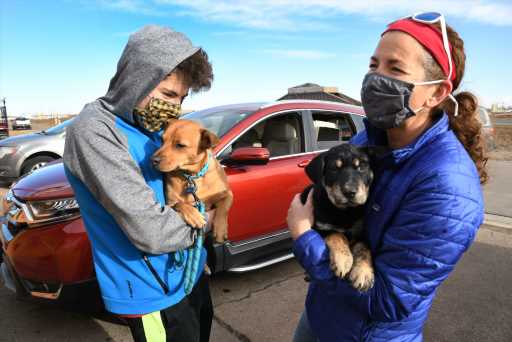First, it was toilet paper, then paper towels and boxed food such as macaroni and cheese.
Now dogs and cats are in demand. Even scorpions.
“It’s been phenomenal. I’ve never seen this industry like it’s been this year,” said Melissa McCalister, co-founder of Red Fern Animal Rescue in Denver. “There’s just been an onslaught of people wanting to adopt.”
The pandemic has created a boom in pet adoptions, with some rescue groups seeing the number of animals being taken to forever homes reaching into the thousands. Most say pet adoptions doubled this year – and there’s a glut of people waiting.
It’s also created a cottage industry for scammers looking to capitalize. The number of complaints nationally about fraudulent and non-existent breeders has never been higher, according to the Better Business Bureau. More than 4,300 complaints about puppy and kitten fraud were expected to be logged by Dec. 31, with losses topping $3.1 million — an increase of nearly 600% from previous years.
Much of it is because the demand for pets is so high and the number of available animals can’t keep up.
“I found a dog on a rescue website that I liked,” explained Teresa Diaz, a paralegal who’s been working from home since the pandemic began in March. “I turned around to tell my kids to come see and when I looked back it literally said ‘adopted.’ In the span of about 8 seconds.”
Whether it’s a desire to add some company to a quiet household, to fill the void left by a previous pet’s death, or simply to keep the kids occupied with a new addition, pet adoptions across Colorado have exploded.
Municipal pounds haven’t seen the same increases as private rescue groups largely because they were forced to close in the early weeks of the pandemic, unable to accept any donations or offer any adoptions.
“We were not processing adoptions at all until May,” said Jessica Nett, a supervisor with the Denver Animal Shelter, so about 120 animals were transferred to outside rescue groups.
Once the doors opened, potential pet owners showed up. People also went online to adopt, paying to put a hold an animal.
From March through December 2019, the agency collected $5,910 in adoption holds. For the same period this year: $7,755, even though the number of adoptions was about half.
“It has been incredibly competitive to adopt,” Nett said. “The first day we were back open for adoptions we had 10 dogs and a line all the way around the building. Every dog available that day got adopted.”
And it wasn’t just dogs or cats. A whip scorpion (sans the stinger), a tarantula, two bearded dragons, several ball pythons, a ferret, even a pair of love birds all found new homes.
At the Aurora Animal Shelter, adoptions have only been half of what they were last year, largely because the shelter was closed until June, supervisor Carol Valentine said. The number of strays also decreased.
“It’s because more people are at home,” she said. “And people were wanting to adopt during our closure, but we just didn’t have any animals to adopt. Then when we did, they were adopted quickly.”
Just before Christmas, the shelter had four dogs and five cats.
At Soul Dog Rescue in Fort Lupton, an adoption center that opened in 2018, the focus is on animals brought from Native American lands in the Four Corners region.
“We go twice a month to do free spaying and neutering, offer food distribution and bring back unwanted litters or animals that are surrendered,” Shelby Davis said. “The demand has been two-fold: Someone on the reservation who lost a job or suffering from COVID needing to surrender, and dozens of people in Colorado waiting to adopt. The jump has been exponential to both sides.”
Soul Dog has seen adoptions jump to more than 2,200 this year from about 1,200 annually, more than three-quarters of them dogs, Davis said.
“The holiday, the second-wave of COVID all factor together,” she said during a recent drive to the Four Corners area, herself recently recovered from COVID-19, the disease caused by the novel coronavirus. “People have the time to potty-train them. We hear all the time that people are working from home, they have the time to devote to a dog or cat.”
The second wave of COVID infections has borne a second wave of pet adoptions.
“People are even adopting them without having met them, or even before they’re off the transport here,” McCalister said. Red Fern concentrates on animals from San Antonio and Fort Worth, Texas, where shelter kill ratios are high.
A school teacher by trade, McCalister said she’s barely keeping up with demand with more than 540 animals adopted this year, a doubling of the work last year.
“Nationally it’s about the same, too,” she said. “We had 16 puppies come in on Dec. 5 and multiple applications for each one of them. Some are elderly or retired who want a companion now. It’s been very difficult because they’re alone.”
Experts frequently warn that adoptions should not be spontaneous, especially at Christmas, with the increased risk of returning an animal once puppies become full-grown or the work necessary to train an animal properly is too much.
But this year feels different to McCalister.
“We understand people will eventually go about their lives as before, but I’m not worried we’ll see them returned,” she said. “I feel these are amazing people who know what they’re doing and have the proper resources.”
Source: Read Full Article







